The ECS Z270H4-I Durathon 2 Mini ITX Motherboard Review
by E. Fylladitakis on September 5, 2017 10:30 AM ESTSystem Performance
Not all motherboards are created equal. On the face of it, they should all perform the same and differ only in the functionality they provide - however, this is not the case. The obvious pointers are power consumption, but also the ability for the manufacturer to optimize USB speed, audio quality (based on audio codec), POST time and latency. This can come down to manufacturing process and prowess, so these are tested.
Power Consumption
Power consumption was tested on the system while in a single MSI GTX 770 Lightning GPU configuration with a wall meter connected to the Corsair AX1200i power supply. This power supply is Platinum rated, and as I am on a 230-240 V supply, leads to ~75% efficiency > 50W, and 90%+ efficiency at 250W, suitable for both idle and multi-GPU loading. This method of power reading allows us to compare the power management of the UEFI and the board to supply components with power under load, and includes typical PSU losses due to efficiency. These are the real-world values that consumers may expect from a typical system (minus the monitor) using this motherboard.
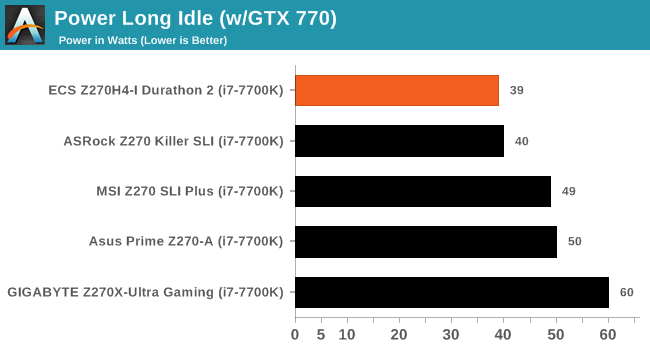

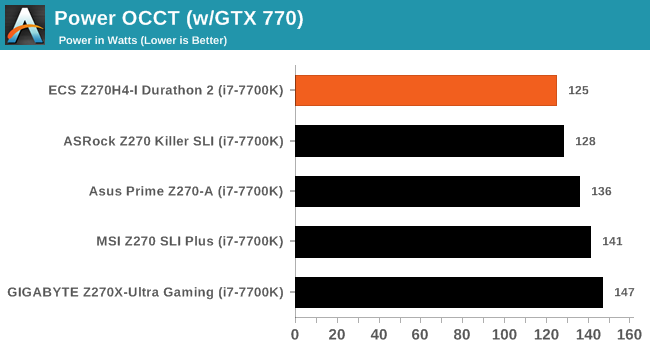
Expectedly, the energy consumption of the ECS Z270H4-I Durathon 2 is a little lower than that of the Z270-based ATX motherboards that we have previously reviewed. The difference, however, is small, with the Z270H4-I Durathon 2 displaying power readings about 3 to 8 watts lower than those of an ATX board with its onboard lighting disabled.
Non-UEFI POST Time
Different motherboards have different POST sequences before an operating system is initialized. A lot of this is dependent on the board itself, and POST boot time is determined by the controllers on board (and the sequence of how those extras are organized). As part of our testing, we look at the POST Boot Time using a stopwatch. This is the time from pressing the ON button on the computer to when Windows 7 starts loading. (We discount Windows loading as it is highly variable given Windows specific features.)

The default boot time of the ECS Z270H4-I Durathon 2 is a little slow, with the motherboard taking quite a while to display the initial BIOS screen. Enabling quick boot does cut that time significantly, bringing the motherboard’s POST boot time down to competitive levels.
Rightmark Audio Analyzer 6.2.5
Rightmark:AA indicates how well the sound system is built and isolated from electrical interference (either internally or externally). For this test, we connect the Line Out to the Line In using a short six inch 3.5mm to 3.5mm high-quality jack, turn the OS speaker volume to 100%, and run the Rightmark default test suite at 192 kHz, 24-bit. The OS is tuned to 192 kHz/24-bit input and output, and the Line-In volume is adjusted until we have the best RMAA value in the mini-pretest. We look specifically at the Dynamic Range of the audio codec used on board, as well as the Total Harmonic Distortion + Noise.
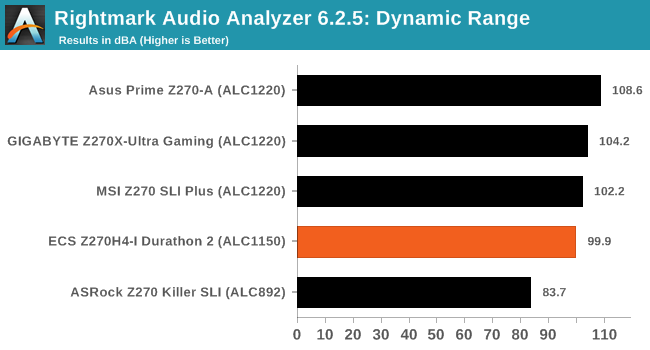
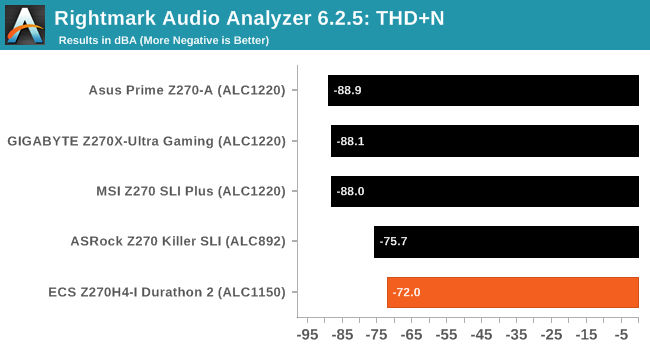
The audio performance figures of the ECS Z270H4-I Durathon 2 are interesting. The Realtek ALC1150 is known to offer good audio quality figures but its implementation on the Z270H4-I Durathon 2 left us with mixed feelings. The dynamic range reached 99.9 dB(A), a very good figure, but the THD + Noise down to -72 dB(A), indicating that there is a lot of interference from other nearby components. This is something to be expected on densely packed ITX motherboards.
USB Backup
For this benchmark, we transfer a set size of files from the SSD to the USB drive using DiskBench, which monitors the time taken to transfer. The files transferred are a 1.52 GB set of 2867 files across 320 folders – 95% of these files are small typical website files, and the rest (90% of the size) are small 30 second HD videos. In an update to pre-Z87 testing, we also run MaxCPU to load up one of the threads during the test which improves general performance up to 15% by causing all the internal pathways to run at full speed.
Due to the introduction of USB 3.1, as of June 2015, we are adjusting our test to use a dual mSATA USB 3.1 Type-C device which should be capable of saturating both USB 3.0 and USB 3.1 connections. We still use the same data set as before, but now use the new device. Results are shown as seconds taken to complete the data transfer.
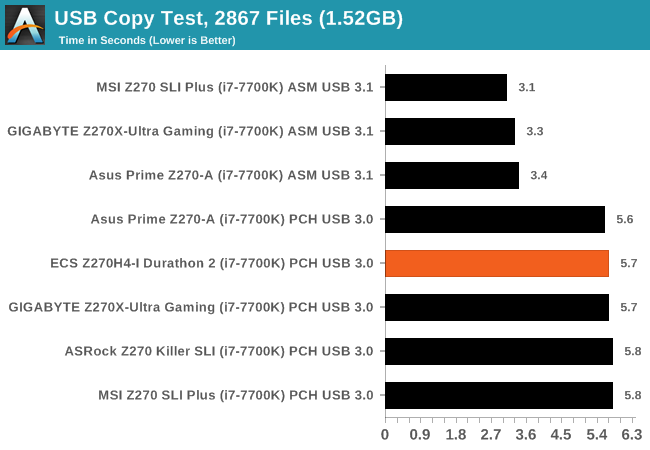
The ECS Z270H4-I Durathon 2 lacks a USB 3.1 controller we were limited to USB 3.0 testing. The USB 3.0 performance of the motherboard is adequate, falling around the ATX motherboards that we have recently tested, but with the performance difference being so small that could be easily attributed to a statistical error.
DPC Latency
Deferred Procedure Call latency is a way in which Windows handles interrupt servicing. In order to wait for a processor to acknowledge the request, the system will queue all interrupt requests by priority. Critical interrupts will be handled as soon as possible, whereas lesser priority requests such as audio will be further down the line. If the audio device requires data, it will have to wait until the request is processed before the buffer is filled.
If the device drivers of higher priority components in a system are poorly implemented, this can cause delays in request scheduling and process time. This can lead to an empty audio buffer and characteristic audible pauses, pops, and clicks. The DPC latency checker measures how much time is taken processing DPCs from driver invocation. The lower the value will result in better audio transfer at smaller buffer sizes. Results are measured in microseconds.

Many manufacturers do not concern themselves with optimizing the DPC latency figures and ECS is apparently one of them. Our maximum reading reached 265 μs, a relatively high figure for a modern motherboard.










19 Comments
View All Comments
Hixbot - Wednesday, September 6, 2017 - link
Audiophilos are not going to use the DAC on a motherboard. They're going to use HDMI to their own DAC in the AVR.petteyg359 - Thursday, September 7, 2017 - link
With a name like that, I'm expecting a 462-pin socket for my old Durons and Athlons :)zodiacfml - Friday, September 8, 2017 - link
Nice enough for me. Are there any competing boards versus this one?Beaver M. - Friday, September 8, 2017 - link
Why would you not test temperatures and power usage of an ITX board?Instead performance benchmarks that always only show how useless they really are...
Beaver M. - Friday, September 8, 2017 - link
Nevermind, Im stupid. Theres power usage at least.Brianmmm - Monday, September 18, 2017 - link
This one is most assuredly NOT useless...http://www.anandtech.com/show/9854/asus-maximus-vi...
MenhirMike - Friday, September 8, 2017 - link
I have that board for my HTPC - it's pretty much the only board that combines Mini-ITX, Display Port out (for HDMI 2.0 since the HDMI on Kaby Lake is still only 1.4) and can be powered with just one (instead of 2) 4-Pin 12V connectors (for owners of some HTPC cases with power supplies that weren't made for higher end systems).The BIOS is pretty bare bones, but for the price, it's a great HTPC board, combined with a Celeron G3930 and 4 Gigs of RAM it's a good package.
MenhirMike - Friday, September 8, 2017 - link
(Also, since Antennas are part of the package, a $20 Intel 8260 WiFi/BT card is all that's needed to avoid having to use a PCIe or USB WiFi solution)EnFission - Friday, September 8, 2017 - link
You can plugin a 4 pin power cable into an 8 pin motherboard connector, you'll just have less power at your disposal. Not that it's a problem with a Celeron G3930. You'd be better off with an Asus Strix B250 board. It has DisplayPort, built-in wifi so you don't have to pay even more, retails for the same price as this ECS board, and is from a much more reputable manufacturer with higher quality parts. Losing out on the Z270 chipset doesn't matter because of your CPU choice and the lack of an 8 pin power connector.